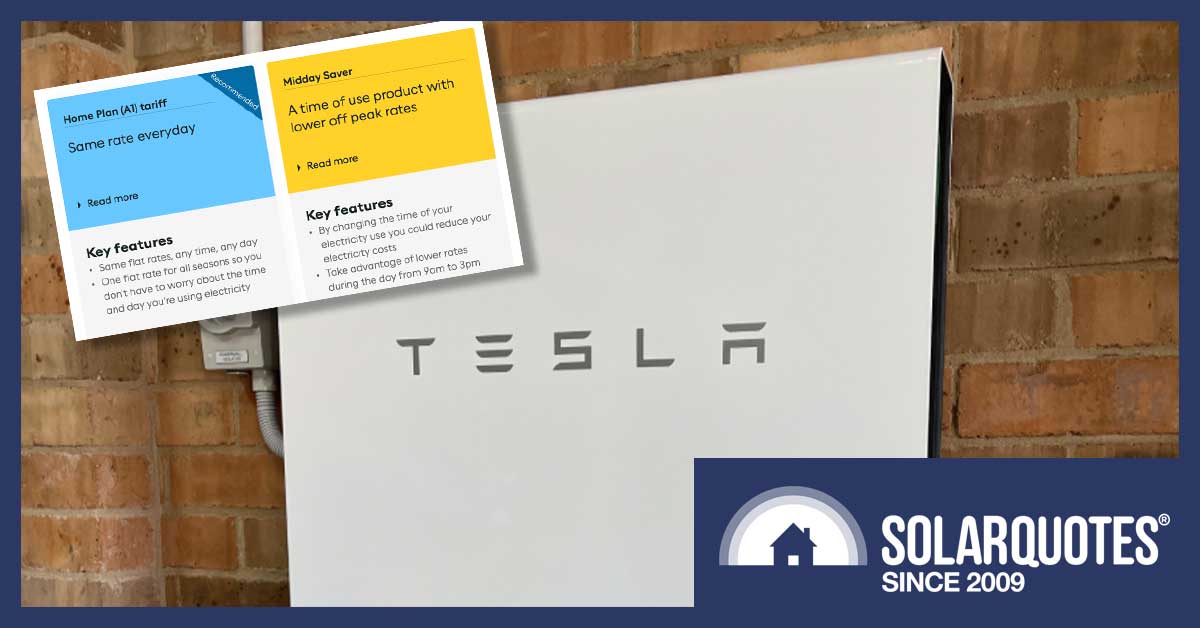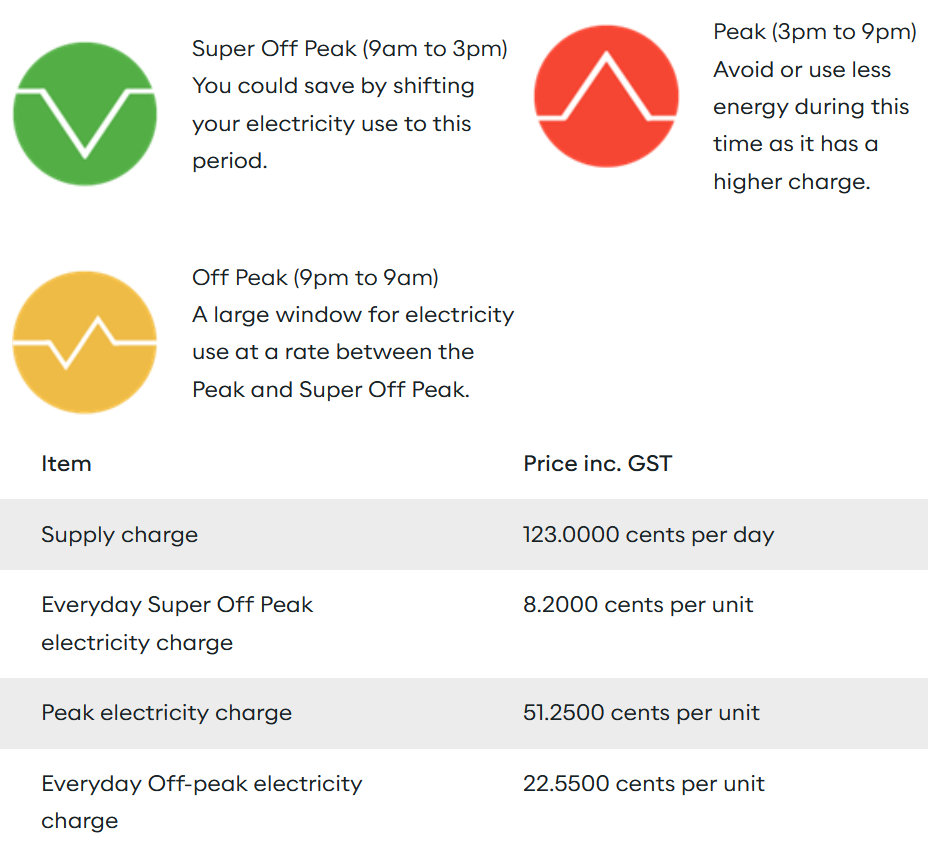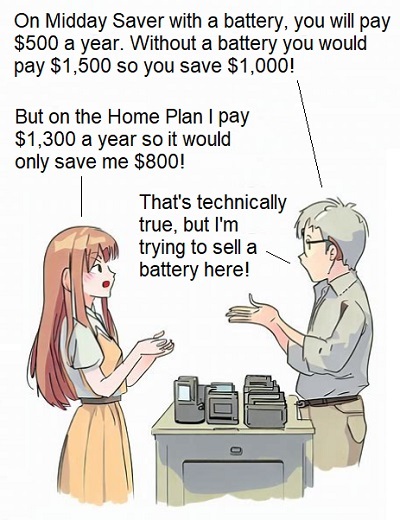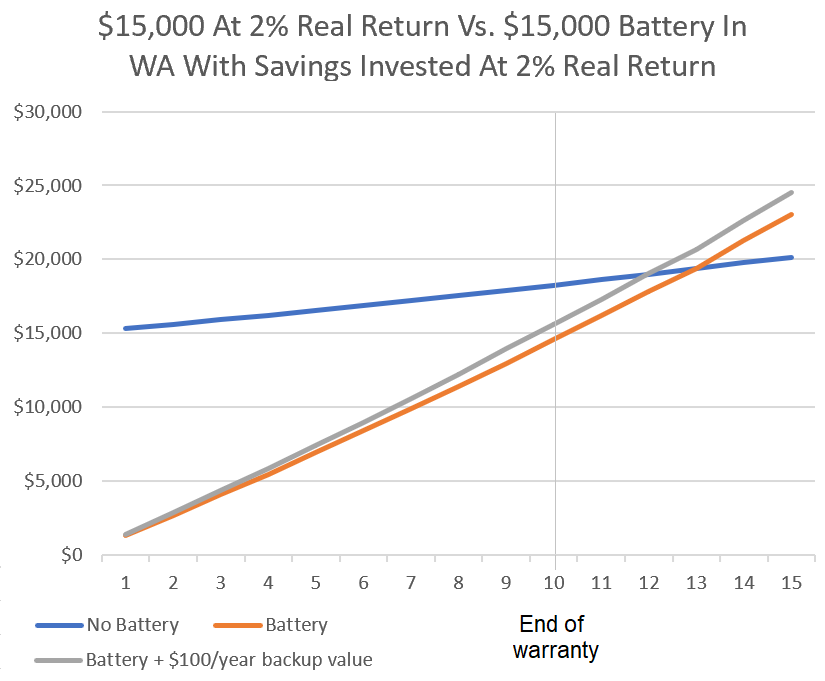
Basking in sunlight from dawn to dusk, Western Australia is a great place for solar panels. But not everyone can install solar, which got me thinking. Is WA a great place for batteries without solar panels?
Local electricity retailer Synergy has capitalised on WA’s sunshine by launching the Midday Saver electricity tariff in the state’s southwest. Offering households grid electricity for only 8.2 cents per kilowatt-hour between 9:00 am and 3:00 pm. It’s a practical, cost-effective way to encourage homes to shift their consumption to the daytime.
An easy but expensive way to do this is with a home battery.
I recently looked into whether the Midday Saver tariff makes batteries worthwhile for solar homes.
But in this post, I’ll investigate if cheap daytime electricity makes solar batteries worthwhile for homes without solar panels.
TL:DR; The answer is “yes” — under the right conditions:
- The home must regularly discharge most of the battery between 3:00 pm and 9:00 pm when grid electricity is 51.25 cents/kWh.
- The household can’t be significantly better off on the flat Home Saver A1 tariff than the Midday Saver plan.
- The cost of capital needs to be low. If money has to be borrowed to buy a home battery, it’s unlikely to pay for itself.
Another factor that can help batteries pay is if a high value is placed on backup power.
And even if the dollar returns are not amazing, some will want a battery to help the environment or simply because it’s a cool piece of technology.
I’ll go into details below to help you decide if installing a solar-less battery will save you money in the Synergy area of WA.

WA’s Synergy area in burnt orange. A lot of Western Australia really is this colour. (Image: Western Power)
Solar-Without-Battery Is Better Than Battery-Without-Solar
Just because a battery without solar can save money doesn’t mean it’s a good idea. Solar power without a battery will save far more than a battery without solar. But there are a number of reasons why solar panels may not be an option. A common one is the home is on a lower level of a block of strata units and doesn’t have a roof. Other possibilities are:
- The roof may be too weak to support solar panels.
- Heavy shading.
- Heritage listing.
- The boss homeowner dislikes the way solar panels look (crazy, but it happens).
- The owners have been badmouthing solar power for years and are now too embarrassed to install it, despite the fact they secretly long for lower electricity bills.
Midday Saver Vs. Home Plan Flat Rate
The Midday Saver plan has a daily supply charge of $1.23 and three rates:
- 9:00 am-3:00 pm Super Off-Peak: 8.2 cents/kWh
- 3:00 pm-9:00 pm Peak: 51.25 cents/kWh
- 9:00 pm-9:00 am Off-Peak: 22.55 cents/kWh
For the benefit of people who love Synergy’s graphics, here’s the same information:

The Midday Saver plan. (Image: Synergy)
The other choice for households is the A1 tariff. This has a supply charge of $1.10 per day and a flat 30.8 cents per kWh of grid electricity consumed. Note that its supply charge comes to $47 less per year — a detail that is easy to overlook when comparing plans.
For this article, I’ll assume households are either better off on the Midday Saver plan or would pay roughly the same amount if they were on the A1 tariff1.

Image: Me… with considerable help from Dall-E Image Creator.
Home Battery Options
A home without solar panels has limited options when choosing a battery. Go to our Solar Battery Comparison Table and look at the row that says “AC or DC coupled (All In One systems only)”. The ones that say they can be AC coupled are suitable.

You want to check out this row on our Solar Battery Comparison Table. (Don’t worry, there are a lot more than three batteries on it.)
While it’s technically possible for other home batteries to be AC coupled and used without solar panels, the easiest option is to use one that’s ready out of the box.
Home Battery Cost
The most popular AC coupled home battery is the Tesla Powerwall 2. While I sometimes feel the Powerwall gets too much attention, it is one of the more reliable batteries and would be my first choice for a home without solar power.
Tesla likes to alter the price of the Powerwall every now and then. Sometimes up and sometimes down. For the purposes of this article, I’m going to assume that a Powerwall 2 — or something very similar — can be installed for $15,000. If you can get it for less than that in the near future from a reliable installer who does high-quality work, that’s great! But for now, I don’t want to be too optimistic in my estimates.
Smaller May Not Be Better
A Powerwall 2 is a fairly large home battery in terms of energy stored. While smaller ones can be cheaper, their cost per useable kWh is generally higher, so going small usually won’t improve the financial return.
A Perfect Situation
A fully charged Powerwall 2 can provide 13.5kWh of stored energy when new. Tesla also claims that new Powerwalls have 90% round-trip efficiency. This means to get one kWh of electricity out, it’s necessary to put 1.11 kWh in. During the daytime Super Off-Peak period, 1kWh (8.2 cents) 1.11 kWh would cost 9.1 cents. This means fully charging it to supply 13.5kWh would cost $1.23.
If all 13.5kWh were used during the six-hour evening peak period (51.25 cents) it would save $6.92 minus the $1.23 cost of charging, for a total saving of $5.69. Over a year, you’d save $2,076 and over 10 years $20,760. Considerably more than the $15,000 cost of the battery system.
But in reality, things won’t be this perfect.
A More Realistic Outcome
The capacity of home batteries declines with use and over time. If a Powerwall 2 gradually falls to 80% of its original capacity after 10 years, then over that time, it would average around 12kWh fully charged.
But even a home with high electricity consumption during the peak period would be unlikely to use the battery’s full capacity every evening. I’ve chosen a 10 kWh average daily discharge.
While Tesla says the Powerwall 2 has a roundtrip efficiency of 90%, they only commit to that when it’s new. So it may be better to use a figure of 88% over its lifetime. This could raise the cost of charging it with 1kWh from 9.1 cents to 9.3 cents. It’s not a large difference, but it’s in the wrong direction.
Electricity prices may not stay the same and could rise or fall. Lower prices will decrease the return from a home battery. I’m confident electricity prices will eventually fall, but not everyone shares my optimism. For simplicity, I’ll assume electricity prices remain constant.
So if a home averages 10kWh of discharge during the peak period, then it will save $4.20 a day. This would be $1,530 a year or $15,300 over 10 years. So even in a household that’s well suited for using a battery without solar, over 10 years the savings will only be slightly more than the cost of the battery.
Battery Lifespan
Battery warranties vary in length and the amount of battery capacity deterioration they allow. When used without solar panels, a Powerwall 2 warranty will last for 10 years or until it has supplied 37,800kWh of stored energy. Whichever comes first. If an average of 10kWh are discharged each day the warranty will last the full 10 years.
Because Powerwalls have shown themselves to be generally reliable, I’m optimistic about their chances of operating for several years after the end of their warranty. If they last for 15 years before going to home battery heaven, then here are the 15-year savings:
- 10kWh daily average: $22,965
- 8kWh daily average: $18,372
- 6kWh daily average: $13,779
So provided the average daily discharge during the Midday Saver Peak period is high and the battery lasts for years beyond the end of its warranty, the savings can be considerable.
Note, I haven’t accounted for inflation. Also, the lower the average daily discharge, the longer the home battery is likely to last.
Off-Peak Battery Discharging
If your battery still has energy left after the Peak period, you can use it during the Off-Peak period, which runs from 9:00 pm to 9:00 am. During this time, the electricity price is 22.55 cents per kilowatt-hour. Factoring in the costs of charging and discharging, you could save 13.4 cents for every kilowatt-hour used. Some argue that this saving isn’t enough to make up for the wear on the battery, but I see it differently.
Think of it this way: once you’ve bought the battery, that money is spent. The real concern with wear and tear should be based on the cost of replacing the battery down the line. I believe that in 10 or more years, home batteries will be much less expensive, so using the remaining energy during Off-Peak times makes sense to me. This approach could modestly increase the return on your battery investment. If it lets you discharge an extra 3 kilowatt-hours on average every day, the savings could add up to about $145 per year or $1,450 over 10 years. Of course, it’s worth noting that this extra usage could shorten the battery’s lifespan.
The Value Of Backup Power
I think its nut’s to install a battery that can’t provide backup. Before buying a home battery, ensure it has backup capability, as not all do.
Then decide what backup is worth to you, whether it’s $100 or $200 a year, which translates to $1,000 or $2,000 over 10 years (or more if the battery lasts longer).
Keep in mind that blackouts can happen when the battery is low, and without solar panels, recharging during an extended blackout is not possible without a generator. Setting a reserve ensures some energy during a blackout but will reduce overall savings.
For me, backup power is worth about $100 a year, more for the convenience and ability to assist friends and neighbours than a particular need.
The Cost Of Capital
A home battery storage system costing $15,000 might seem like it breaks even if it provides $15,000 in savings over its life. However, it’s not that simple. You have to consider the cost of capital, meaning the money spent on the battery could have been used differently, like investing or paying off interest if borrowed.
Imagine you use the $15,000 to pay off your home; you might see a real return of about 3%. If you put it in a bank term deposit, the real return might be 2% or less.
The graph below helps illustrate this. It shows two scenarios for a 15-year period:
- Investing $15,000 at a 2% real return.
- Using the $15,000 to buy a battery system (without solar), discharging an average of 8kWh a day during the Midday Saver Peak period and 2kWh during the Off-Peak period. Plus, all the savings from the home battery are invested at that same 2% real return.
This comparison helps you see the financial implications of choosing the battery system over other investment options.
The blue line representing $15,000 invested at 2% is crossed by the orange line representing battery savings just before 13 years. If the battery continues to work for three years beyond the end of its warranty, it will provide a higher return.
You may have noticed there’s also a grey line on the graph. This is the same as the orange line, except for assuming the household gets $100 a year from backup power. In this case, the blue line is crossed by the grey line at a little before 12 years.
Many Australian households will discharge a daily average of 8kWh or more during the peak period and another 2kWh during the off-peak period. I also think it’s reasonable to expect a good quality home battery to last 2-3 years past the end of its warranty. So a battery without solar can pay for itself in the Synergy area of WA, provided the cost of capital is reasonably low. It also helps if a high value is placed on having backup power.
Home Battery Without Solar No Problem For Some
I hope this article will convince some people in WA to consider buying a battery even if they can’t install a solar power system. The more people who take the environmentally beneficial step of installing a home battery, the better. But because it’s not a clear money saver like solar panels, other options for energy savings should be considered. Getting off gas or buying an EV could provide a better return under the right circumstances.
But in the future, when battery prices are lower, it may make sense for almost every household to have a battery, whether it has solar or not.
Footnotes
- If the household would be better off on the flat rate A1 tariff, then getting a home battery may still be worthwhile, but to work out the savings, it will be necessary to estimate what the household would pay with a battery on the Midday Saver plan and then compare that to what they would pay without a battery on the Home Plan ↩


 RSS - Posts
RSS - Posts



The age pension has an asset test which can cause a reduction in pension payments. If someone in that situation spent $15k on a battery (or solar) then they would also get an increased pension which would help the NPV considerably
But sadly the ATO considers it infrastructure so claiming installation and depreciation it as a UPS for your internet and IT facilities is hard. Even speaking of depreciation of plant on a new property may see such labelled as a “scheme”. But I applaud the aged pensioner spending down the assets.
Hi Matthew, I think we are on different pages here. I’m not suggesting claiming expenses to offset income and pay less tax. I’m just saying if you have so many assets (which includes your super balance) that you fail the income test you could spend some cash on the solar/battery so that you pass the income test and thereby collect some pension. It only works if your assets are in a particular range
Consider also that you may have a block of 20 flats, Getting rid of the connection charge for all but the common property is a serious saving, especially if the connection charge is a significant chunk of the daily cost.
(In the ACT connection tariffs have recently jumped over 40%. People who use the least power are punished the most).
Is “usable” storage a misnomer.?
I have a Alpha-ess battery, but I can’t comment on other makes, but I would be interested to know if the comment below applies also to other makes.
The battery discharge setting is set to never go below 15%, so the “useable” energy of 85% is far lower than the rating of the unit.
I was told that changing the setting to less than 15% would make it “unstable”